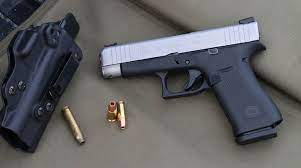Military
Handgun Protection Turkey - Turkish Manufacturer

There are a few different types of handgun protection systems that are commonly used. Some examples include:
Physical locks: These are devices that physically prevent the handgun from being fired. They can be in the form of a cable lock, trigger lock, or chamber lock. Cable locks are placed through the barrel or action of the handgun and prevent it from being fired. Trigger locks are devices that fit over the trigger and prevent it from being pulled. Chamber locks are inserted into the chamber of the handgun and prevent a round from being chambered.
Electronic locks: These are devices that require a code or key to unlock the handgun. Some electronic locks use a keypad or touch screen to enter a code, while others use a key or other physical object to unlock the handgun.
Biometric locks: These are locks that use a fingerprint or other biometric characteristic to unlock the handgun. Some biometric locks use a fingerprint scanner, while others use facial recognition or other biometric technologies.
It's important to carefully consider the type of handgun protection system that is best for your needs. Physical locks may be the most secure, but they may also be the most cumbersome to use. Electronic locks may be more convenient, but they can be vulnerable to electronic failure or tampering. Biometric locks may be the most convenient, but they may also be the most expensive and can be affected by changes in the biometric characteristic being used (such as a cut on a finger used for fingerprint scanning).
Regardless of the type of handgun protection system you choose, it's important to follow the manufacturer's instructions for use and to regularly test and maintain the system to ensure that it is functioning properly.
A handgun protection system is a device or set of devices that is designed to help prevent unauthorized use or access to a handgun. These systems can take various forms, including physical locks that prevent the handgun from being fired, electronic locks that require a code or key to unlock, and biometric locks that use a fingerprint or other biometric characteristic to unlock. Some handgun protection systems are designed to be used with a specific make and model of handgun, while others can be used with a variety of different handguns.
There are several reasons why someone might want to use a handgun protection system. For example, if a handgun is kept in a home with children, a protection system can help prevent accidental discharge or unauthorized access to the firearm. Similarly, if a handgun is carried for self-defense, a protection system can help prevent an attacker from taking control of the firearm.
It's important to note that no handgun protection system is completely foolproof, and they should not be relied upon as the sole means of preventing unauthorized access or use of a handgun. In addition, it's important to follow all applicable laws and regulations regarding the use and storage of firearms, including any requirements for the use of handgun protection systems.
Handgun Protection Turkey - Turkish Manufacturer
Handgun Protection Turkey - Turkish Manufacturer
There are a few different types of handgun protection systems that are commonly used. Some examples include:
Physical locks: These are devices that physically prevent the handgun from being fired. They can be in the form of a cable lock, trigger lock, or chamber lock. Cable locks are placed through the barrel or action of the handgun and prevent it from being fired. Trigger locks are devices that fit over the trigger and prevent it from being pulled. Chamber locks are inserted into the chamber of the handgun and prevent a round from being chambered.
Electronic locks: These are devices that require a code or key to unlock the handgun. Some electronic locks use a keypad or touch screen to enter a code, while others use a key or other physical object to unlock the handgun.
Biometric locks: These are locks that use a fingerprint or other biometric characteristic to unlock the handgun. Some biometric locks use a fingerprint scanner, while others use facial recognition or other biometric technologies.
It's important to carefully consider the type of handgun protection system that is best for your needs. Physical locks may be the most secure, but they may also be the most cumbersome to use. Electronic locks may be more convenient, but they can be vulnerable to electronic failure or tampering. Biometric locks may be the most convenient, but they may also be the most expensive and can be affected by changes in the biometric characteristic being used (such as a cut on a finger used for fingerprint scanning).
Regardless of the type of handgun protection system you choose, it's important to follow the manufacturer's instructions for use and to regularly test and maintain the system to ensure that it is functioning properly.
A handgun protection system is a device or set of devices that is designed to help prevent unauthorized use or access to a handgun. These systems can take various forms, including physical locks that prevent the handgun from being fired, electronic locks that require a code or key to unlock, and biometric locks that use a fingerprint or other biometric characteristic to unlock. Some handgun protection systems are designed to be used with a specific make and model of handgun, while others can be used with a variety of different handguns.
There are several reasons why someone might want to use a handgun protection system. For example, if a handgun is kept in a home with children, a protection system can help prevent accidental discharge or unauthorized access to the firearm. Similarly, if a handgun is carried for self-defense, a protection system can help prevent an attacker from taking control of the firearm.
It's important to note that no handgun protection system is completely foolproof, and they should not be relied upon as the sole means of preventing unauthorized access or use of a handgun. In addition, it's important to follow all applicable laws and regulations regarding the use and storage of firearms, including any requirements for the use of handgun protection systems.


